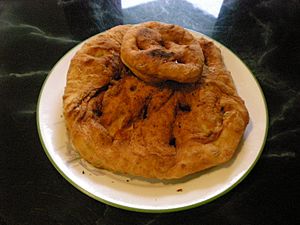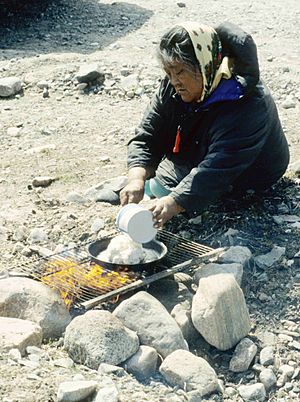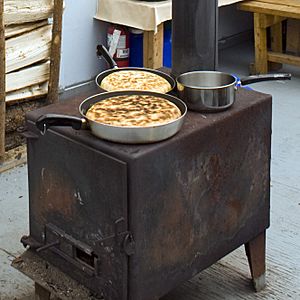Bannock (Indigenous American) facts for kids

Bannock, also known as skaan, Indian bread, or frybread, is a type of bread enjoyed by many Indigenous peoples across North America. This includes the Inuit in Canada and Alaska, other Alaska Natives, the First Nations in Canada, Native Americans in the United States, and the Métis.
Where Did Bannock Come From?

The exact story of bannock's origins in North America is interesting. Some people believe that Indigenous North Americans made a type of bread similar to bannock long before Europeans arrived. They might have used local ingredients like flour from maize (corn), different roots, or even tree sap. This early bread would have been like a simple, traditional cornbread.
However, other stories suggest that bannock came to North America later. One idea is that it came from Scotland. Another claim is that it was first made by the Navajo in the 1860s. This happened when they were held at Fort Sumner.
Many Native American tribes, such as the Nez Perce, Cree, Coast Salish, Lummi, and Blackfoot, traditionally ate camas bulbs. These bulbs could be used to make flour for bannock. Camas bulbs were so important that they even helped members of the Lewis and Clark Expedition survive during their journey from 1804 to 1806.
How Is Bannock Made?
Bannock is usually made with simple ingredients. These include white or whole wheat flour, baking powder, sugar, and lard. Water or milk is then added to mix everything together. Sometimes, people add spices, dried fruits, or other flavors to make it taste even better.
Once the ingredients are combined, the dough is kneaded. Then, it can be cooked in different ways:
- It can be fried in rendered fat, vegetable oil, or shortening.
- It can be baked in an oven.
- It can be wrapped around a stick and cooked over an open fire.
Bannock and Indigenous Peoples
Bannock has always been very important to Indigenous peoples in North America. Its meaning and role have changed over time.
Before European contact, many Indigenous groups made bannock from corn and nut meal. They also used flour from various roots and ground plant bulbs. Sometimes, they sweetened it with syrup from trees. There were many different ways to make and cook bannock depending on the region. Some groups rolled the dough in sand and cooked it in a pit. Others baked it in clay or rock ovens. Some even wrapped the dough around a green, hardwood stick and toasted it over a fire. Bannock was a practical food that could be cooked and eaten easily while doing daily activities, hunting, trapping, fishing, or gathering.
However, colonization greatly changed the traditional lives of Indigenous Americans, and this also affected their relationship with bannock. What was once a useful food for travel and work became a necessary food for survival. When Indigenous peoples were forced to live on reservations, they lost many of their traditional food sources. The government often provided food rations, which usually included flour and lard. Because of this, traditional knowledge about edible plants and natural foods was sometimes lost. Wheat and flour became common ingredients in Indigenous bannock recipes, changing how it was made.


